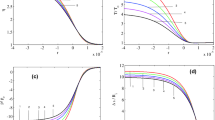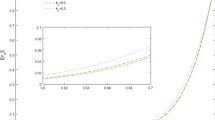Abstract
Shock-wave and detonation flows in a two-phase medium consisting of a gas and incompressible particles are studied by methods of numerical simulation with allowance for the random motion and collisions of particles. Steady solutions corresponding to two previously predicted wave types are obtained for the problem of interaction of a plane shock wave with a cloud of particles. The influence of the mixture parameters on the corresponding solutions is determined. In considering the problem of propagation of cellular heterogeneous detonation in a mixture of reacting particles, oxidizer, and inert particles, it is found that the detonation flow structure and the cell size are retained in the mixture with particle collisions. However, smearing (dispersion) of the layers and inert phase structures formed in the far zone of cellular detonation occurs because of particle collisions.
Similar content being viewed by others
References
N. N. Yanenko, R. I. Soloukhin, A. N. Papyrin, and V. M. Fomin, Supersonic Two-Phase Flows under Conditions of Velocity Nonequilibrium of Particles (Nauka, Novosibirsk, 1980) [in Russian].
A. V. Fedorov, V. M. Fomin, and T. A. Khmel’, Heterogeneous Detonation of Gas Suspensions (Izd. NGTU, Novosibirsk, 2012) [in Russian].
M. R. Baer and J. W. Nunziato, “A Two-Phase Mixture Theory for the Deflagration to Detonation Transition (DDT) in Reactive Granular Materials,” Int. J. Multiphase Flow 12, 861–889 (1986).
J. B. Bdzil, R. Menikoff, S. F. Son, A. K. Kapila, and D. S. Stewart, “Two-Phase Modeling of DDT in Granular Materials: A Critical Examination of Modeling Issues,” Phys. Fluids 11, 378–402 (1999).
A. G. Kutushev, Mathematical Modeling of Wave Processes in Aerodisperse and Powdered Media (Nedra, St. Petersburg, 2003) [in Russian].
D. Gidaspow, Multiphase Flow and Fluidization: Continuum and Kinetic Theory Descriptions (Academic Press, Boston, 1994).
B. C. Fan, Z. N. Chen, X. H. Jiang, and H. Z. Li, “Interaction of a ShockWave with a Loose Dusty Bulk Layer,” Shock Waves 16, 179–187 (2007).
A. L. Kuhl and K. Balakrishnan, “Gasdynamic Model of Dilute Two-Phase Combustion Fields,” Fiz. Goreniya Vzryva 48(5), 59–76 (2012) [Combust., Expl., Shock Waves 48 (5), 544–560 (2012)].
T. A. Khmel’ and A. V. Fedorov, “Description of Dynamic Processes in Two-Phase Colliding Media with the Use of Molecular-Kinetic Approaches,” Fiz. Goreniya Vzryva 50(2), 81–93 (2014) [Combust., Expl., Shock Waves 50 (2), 196–207 (2014)].
B. E. Gel’fand, S. P. Medvedev, A. N. Polenov, et al., “Measurement of the Velocity of Weak Disturbances of Bulk Density in Porous Media,” Prikl. Mekh. Tekh. Fiz. 27(1), 141–144 (1986) [Appl. Mech. Tech. Phys. 27 (1), 127–130 (1986)].
A. V. Fedorov and Yu. V. Kratova, “Calculation of Detonation Wave Propagation in a Gas Suspension of Aluminum and Inert Particles,” Fiz. Goreniya Vzryva 49(3), 88–101 (2013) [Combust., Expl., Shock Waves 49 (3), 335–347 (2013)].
A. V. Fedorov and T. A. Khmel’, “Numerical Technologies of Studying Heterogeneous Detonation of Gas Suspensions,” Mat. Model. 18(8), 49–63 (2006).
T. A. Khmel’ and A. V. Fedorov, “Interaction of a Shock Wave with a Cloud of Aluminum Particles in a Channel,” Fiz. Goreniya Vzryva 38(2), 89–98 (2002) [Combust., Expl., Shock Waves 38 (2), 206–214 (2002)].
G. Ben-Dor, A. Britan, T. Elperin, O. Igra, and J. P. Jiang, “Experimental Investigation of the Interaction between Weak Shock Waves and Granular Layers,” Exp. Fluids 22, 432–443 (1997).
A. V. Fedorov, “Shock Wave Structure in a Mixture of Two Bodies (Hydrodynamic Approximation),” Model. Mekh. 5(4), 135–158 (1991).
A. V. Fedorov and N. N. Fedorova, “Structure, Propagation, and Reflection of Shock Waves in a Mixture of Solids (The Hydrodynamic Approximation,” Prikl. Mekh. Tekh. Fiz. 33(4), 10–18 (1992) [Appl. Mech. Tech. Phys. 33 (4), 487–493 (1992)].
Author information
Authors and Affiliations
Corresponding author
Additional information
Original Russian Text © T.A. Khmel’, A.V. Fedorov.
Published in Fizika Goreniya i Vzryva, Vol. 50, No. 5, pp. 53–62, September–October, 2014.
Rights and permissions
About this article
Cite this article
Khmel’, T.A., Fedorov, A.V. Modeling of propagation of shock and detonation waves in dusty media with allowance for particle collisions. Combust Explos Shock Waves 50, 547–555 (2014). https://doi.org/10.1134/S0010508214050104
Received:
Published:
Issue Date:
DOI: https://doi.org/10.1134/S0010508214050104




